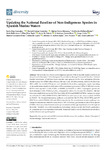| dc.contributor.author | Png-González, Lydia | |
| dc.contributor.author | Comas-González, Robert | |
| dc.contributor.author | Calvo-Manazza, Matías | |
| dc.contributor.author | Follana-Berná, Guillermo | |
| dc.contributor.author | Ballesteros, Enric | |
| dc.contributor.author | Díaz-Tapia, P. | |
| dc.contributor.author | Falcón, Jesús M. | |
| dc.contributor.author | García Raso, José Enrique | |
| dc.contributor.author | Gofas, Serge Salvator | |
| dc.contributor.author | González-Porto, M. | |
| dc.contributor.author | López, Eduardo | |
| dc.contributor.author | Ramos Esplá, Alfonso | |
| dc.contributor.author | Velasco, Eva | |
| dc.contributor.author | Carbonell, Ana | |
| dc.date.accessioned | 2023-07-14T18:29:55Z | |
| dc.date.available | 2023-07-14T18:29:55Z | |
| dc.date.issued | 2023-05-05 | |
| dc.identifier.citation | Png-Gonzalez, L.; Comas-González, R.; Calvo-Manazza, M.; Follana-Berná, G.; Ballesteros, E.; Díaz-Tapia, P.; Falcón, J.M.; García Raso, J.E.; Gofas, S.; González-Porto, M.; et al. Updating the National Baseline of Non-Indigenous Species in Spanish Marine Waters. Diversity 2023, 15, 630. https://doi.org/10.3390/d15050630 | es_ES |
| dc.identifier.issn | 1424-2818 | |
| dc.identifier.uri | http://hdl.handle.net/2183/33326 | |
| dc.description | This article belongs to the Special Issue Trends in Marine Non-Indigenous Species in Europe by 2020, and Predictions through Modelling and Horizon Scanning for 2050 | es_ES |
| dc.description.abstract | [Abstract] The introduction of new non-indigenous species (NIS) in Spanish marine waters is addressed under Descriptor 2 of the European Union’s Marine Strategy Framework Directive. National baseline inventories of NIS have been compiled and updated for the three subregions (Western Mediterranean Sea, WMED; Bay of Biscay–Iberian Coast, ABI; Macaronesia, AMA) with data from 1800 to 2021. An overall of 574 species were identified with an alien, cryptogenic, crypto-expanding, or debatable status, mostly invertebrates (~65%) and primary producers (~22%). Of 412 alien species, 80.51% were reported in ABI, 67.82% in WMED, and 66.67% in AMA. Cryptogenic species are more abundant in the WMED (25.25%), compared to AMA (19.77%) and ABI (18.46%). ABI harbors more established species (62.56%) than AMA (45.2%) and WMED (43.56%), contrary to casual records (AMA 31.64%, WMED 23.76%, ABI 13.85%). Invasive species are more abundant (14.36%) in WMED. The ‘transport-stowaway’ pathway accounted for 142 (79.33%), 123 (67.58%), and 169 (85.21%) records in WMED, ABI, and AMA, respectively. The second most common pathway was ‘transport-contaminant’ related to mariculture (~10% of the total), prevalently in ABI with 42 species (23.08%). The Canary Islands stand out for species introduced through oil platforms from throughout the world. ‘Unaided’ was a relevant pathway of secondary introduction into the WMED, particularly of Lessepsian species progressing westwards. Temporal trends in newly introduced species show similar behavior among subregions. | es_ES |
| dc.description.sponsorship | This research was funded by Ministerio para la Transición Ecológica y el Reto Demográfico, grant number 11_MM_ESMARES2. The APC was funded by the ESMARES2-C3 project | es_ES |
| dc.language.iso | eng | es_ES |
| dc.publisher | MDPI | es_ES |
| dc.relation.uri | https://doi.org/10.3390/d15050630 | es_ES |
| dc.rights | Atribución 4.0 Internacional | es_ES |
| dc.rights.uri | http://creativecommons.org/licenses/by/4.0/ | * |
| dc.subject | Alien species | es_ES |
| dc.subject | National NIS inventories | es_ES |
| dc.subject | Mediterranean Sea | es_ES |
| dc.subject | Northeast Atlantic | es_ES |
| dc.subject | Descriptor 2 | es_ES |
| dc.subject | Marine Strategy Framework Directive | es_ES |
| dc.title | Updating the National Baseline of Non-Indigenous Species in Spanish Marine Waters | es_ES |
| dc.type | info:eu-repo/semantics/article | es_ES |
| dc.rights.access | info:eu-repo/semantics/openAccess | es_ES |
| UDC.journalTitle | Diversity | es_ES |
| UDC.volume | 15 (2023) | es_ES |
| UDC.issue | 5 | es_ES |
| UDC.startPage | 630 | es_ES |
| dc.identifier.doi | 10.3390/d15050630 | |






